Written by Branford Walker
Croatia
Croatia is the jewel of the Adriatic, with over a thousand miles of pristine coastline and over a thousand individual island, each speckled with white boulders and hemmed by the azure waters of the Adriatic, it is no wonder that Croatia is quickly becoming one of the most sought-after destinations in the world. The Croatian landscape itself seems to be conjured up from an impossibly peaceful dream.
The countryside is abundant with vineyards and olive orchards, while the arid coastline is thrown into stunning relief with the Adriatic. The islands of Croatia all have distinct personalities and destinations. They harbor everything from remote fishing villages to luxurious resorts. Croatia’s nature projects an ancient majesty and its villages maintain a sense of modern comfort.
Tourism makes up a large part of Croatia’s economy and the culture and country are both welcoming to guests.
Stunning Villages & Cities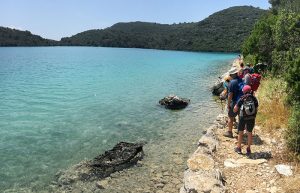
The villages and cities of Croatia are some of the most stunning in the world. The architecture is truly suspended in time, built with stucco walls and red brick roofs. These red buildings run down to the seaside, where palm trees skirt the precipitous edge of the sea. The villages of the Croatian islands Korcula and Mljet are often the only major population centers on the entire islands.
Historically distinct, these villages are marked by both the ruins of ancient and medieval villages. They also provide access to a host of destinations which are distinguished instead through myth, such as locations tantalizingly referred to as Odysseus Cave or the Fairies Canyon (Divica is the term for a fairy in Croatian mythology).
Beyond these locations, these villages support active fishing cultures, as well as plenty of quiet coves and boardwalks where locals and tourists alike love to bask in the uniquely refreshing Adriatic water.
Coastal towns such as Split and Dubrovnik are distinguished by towering medieval castles and walls. They also support lively beachside bars and restaurants. Dubrovnik, in particular, has gained a status of celebrity as the location home to the Red Keep in the fantasy books and show Game of Thrones. When traveling through Croatia you are truly traveling through both history and fantasy.
Fresh Cuisine
The food in Croatia is reason enough to travel to the country alone. The cuisine is bolstered by the abundance of fresh fish in the region, with octopus, squid, and brodetto: a Croatian seafood stew. For a drink, the Croatian wines are diverse and rival the larger wine producing countries in terms of quality, while far surpassing them in terms of affordability. The locals of Croatia are also fans of drinking grappa and spirits, locally produced and sold, providing the perfect nightcap for the end of a day traveling through the arid Croatian countryside.
World-Class Hiking
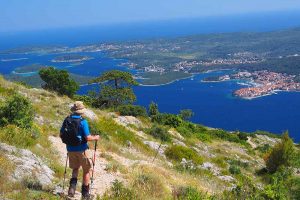 Hiking in Croatia is as unique as the country itself. The Croatian national parks, such as the Biokovo national park and Mljet national park, are truly undisturbed areas of nature, featuring inland lakes and breathtaking views of the sea.
Hiking in Croatia is as unique as the country itself. The Croatian national parks, such as the Biokovo national park and Mljet national park, are truly undisturbed areas of nature, featuring inland lakes and breathtaking views of the sea.
The hiking varies between rocky trails and dirt roads, leading to breathtaking vistas of the sea and large inland lakes. The Croatian mountains have their own majesty due to their proximity to the sea. The peak Svet Ilja is a destination popular for Croatian hikers and climbers.
Why You Should Book Now
Croatia is a country draped by history, mythic mystery, and natural beauty. It is a country unlike any other, with a turbulent modern and ancient history. It was defined by the land conflicts surrounding both Yugoslavia and previously the Ottoman empire. Croatia has now grown into a peaceful and truly magical destination that should be on any adventurer’s bucket list!
Montenegro
From Mountains to Sea in Montenegro
Montenegro is a small, magical country in Southeast Europe with a population of less than 630,000. Half the size of Vermont, Montenegro, like the Green Mountain State, is named for its Black Mountains. Nestled between Croatia, Serbia, Bosnia and Herzegovina. Montenegro even sounds exotic compared to its more Slavic-named neighbors.
Montenegro is home to some of Europe’s most rugged peaks, oldest forests, deepest canyons and captivating coastal shores. Defined by the Dinaric Alps, the range extends northeast to southeast for 400 miles. Alpine areas include barren plateaus, jagged 2,000 meter-peaks and karst topography which explains the absence of surface streams as well as fascinating limestone formations, subterranean sinkholes, canyons and caves.
Montenegro’s magnificent 180-mile coast along the Adriatic Sea is exclusively cliffs and fjords, broken only by the Bay of Kotor. The broad bay has beaches and seaside villages. Discovered by the Ancient Romans, the coast has a Mediterranean vibe. In September, there are less tourists and warm enough weather to swim.
Adriatic Sea
Compared to the Italian spoken across Adriatic, the Montenegrin language may sound harsh, but the people are warm and welcoming. From the Byzantine and Ottoman Empires to Yugoslavia, century-long fights over independence – achieved June 3, 2006 – explain the Montenegrin spirit. The natives are eager to share their country’s wealth of scenery. Although the Euro is the currency, Montenegro is not part of the European Union.
High in the Hills, Down by the Bay
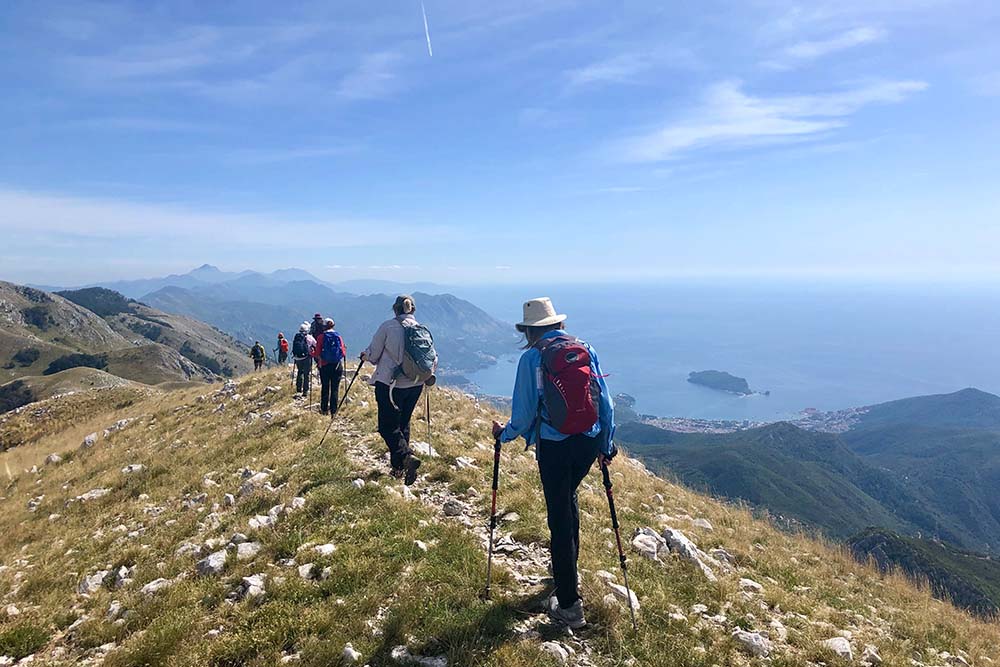 Treks in Montenegro tackle a vast array of wilderness. Protected since 1878, in the central Bjelasica Mountains, Biogradska Gora National Park has one of the last three virgin forests in Europe with ancient trees half a millennium old.
Treks in Montenegro tackle a vast array of wilderness. Protected since 1878, in the central Bjelasica Mountains, Biogradska Gora National Park has one of the last three virgin forests in Europe with ancient trees half a millennium old.
Ryder-Walker’s meandering 10-mile hike above tree-line gains 2,600 vertical feet through green pastures and wildflower meadows. Marvel at the view of the park’s six glistening lakes, including Biogradska Jezero, the park’s namesake. Black Head Mountain, Crna Glava, is the park’s highest point, 7,017 feet.
Our 9-mile loop in the park’s upper regions ascends to the top of Ogorela Glava, 6,562 feet, then descends 2,800 feet through old-growth beech, fir, juniper, maple and elm trees – some 200 feet tall. Further down the trail, Lake Biograd, is the park’s largest glacial lake.
Surrender to the flow as you raft down the Tara River Canyon, the second deepest canyon in the world. Nicknamed the “Tear of Europe,” a day of rafting includes 21 exciting whitewater rapids with sheer rock walls rising 4,000 feet overhead.
National Park Dumitor
In the northwest, National Park Dumitor is Montenegro’s largest land preserve, established in 1952, a UNESCO World Heritage Sites since 1980. Due to ice-erosion and glacial activity, this is one of Europe’s most rugged ranges with 48 peaks above 6,000 feet. The highest is Bobotov Kuk at 8,277 feet.
The park has 18 alpine lakes including the iconic Black Lake, Crno Jezer, with Medjed Peak (7,503 feet) in the backdrop. Hiking, rock climbing, canoeing and rafting – Tara River Canyon is within park boundaries – draws worldwide ecotourism. The park also attracts large populations of bears, wolves and lynx.
Rooted in antiquity, the Bay of Kotor has various trails connecting the ancient towns. The bay is also within walking distance of Lovćen National Park. Here, hikes contour the coastline with breathtaking views of the bay.
Meet Me in Montenegro: Towns
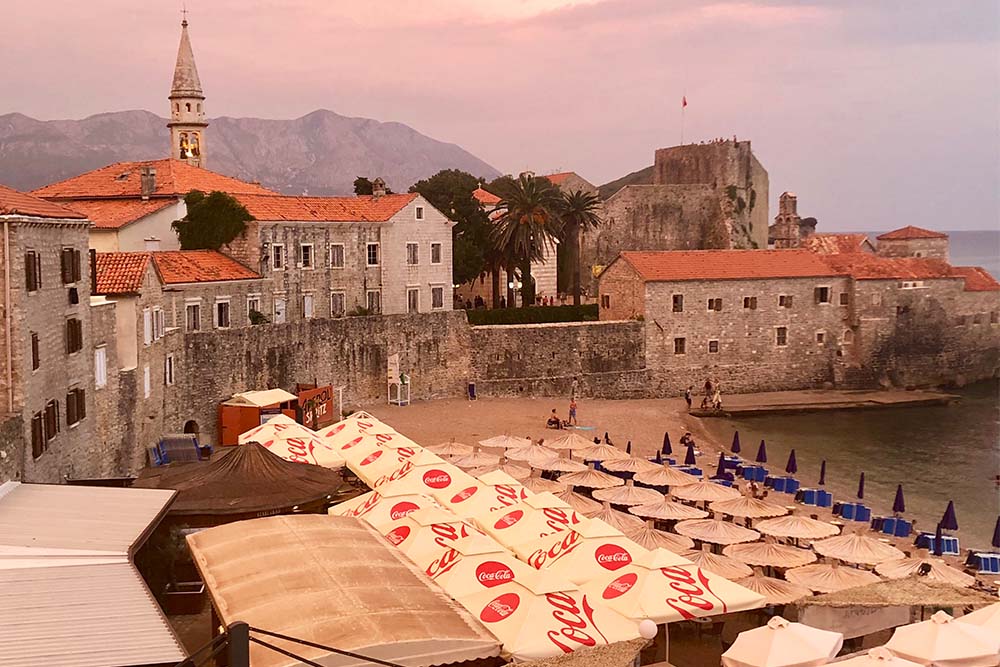 Montenegro is a tricky travel destination hence highly undiscovered. Arrive by plane to the capital city of Podgorica. From mountains to sea, Montenegro accommodates with rustic charm.
Montenegro is a tricky travel destination hence highly undiscovered. Arrive by plane to the capital city of Podgorica. From mountains to sea, Montenegro accommodates with rustic charm.
The town of Kolašin at the entrance of Biogradska National Park is a ski resort with numerous trails and rivers. The old town was constructed in the mid-17th century by the Turks. During World War II, Kolašin was occupied 22 times, back and forth, between the Italians, Germans and more.
A night’s stay at Eco Katun, an alpine farm turned ecological resort, is a memorable mountain escape. Arrive via trail, and your luggage and individual wooden hut await. Since the farm is still active, guests can participate in chores like milking cows and splitting wood or go horseback- and mountain bike-riding.
National Park Durmitor is easily accessed from Žabljak – Montenegro’s biggest ski area and highest Balkan city, 4,780 feet. The Tara River Canyon is 15 minutes by car. In Mojkovac, mining ruins from the early 1200s are a testament to the tough landscape. Today, however, numerous lodges offer modern-day amenities like spas and terraces. Hotel Soa, within park boundaries, is considered one of the country’s best. Sample homemade schnapps at Hotel Resort Gacka, made from fruit grown on the property.
Bay of Kotor
From mountain simplicity to the Bay of Kotor, the seashore is slightly more sophisticated. Dating back to third century BC, it might even feel like Venice as you roam the cobbled streets or sip coffee in the square. Take a boat ride to Gospa od Škrpjela, Our Lady of the Rocks, an artificial island constructed from abandoned ships and rocks.
The medieval town of Perast is rich in culture with 16 churches and 17 grand palazzos. Kotor’s old town walls were erected during the Venetian Era, but modern facilities like Hotel Hippocampus, a 12-room boutique hotel, cater to today’s guests. The quaint seaside village of Budva is quite popular with its sandy beaches.
Sunday Supper to Seafood Galore
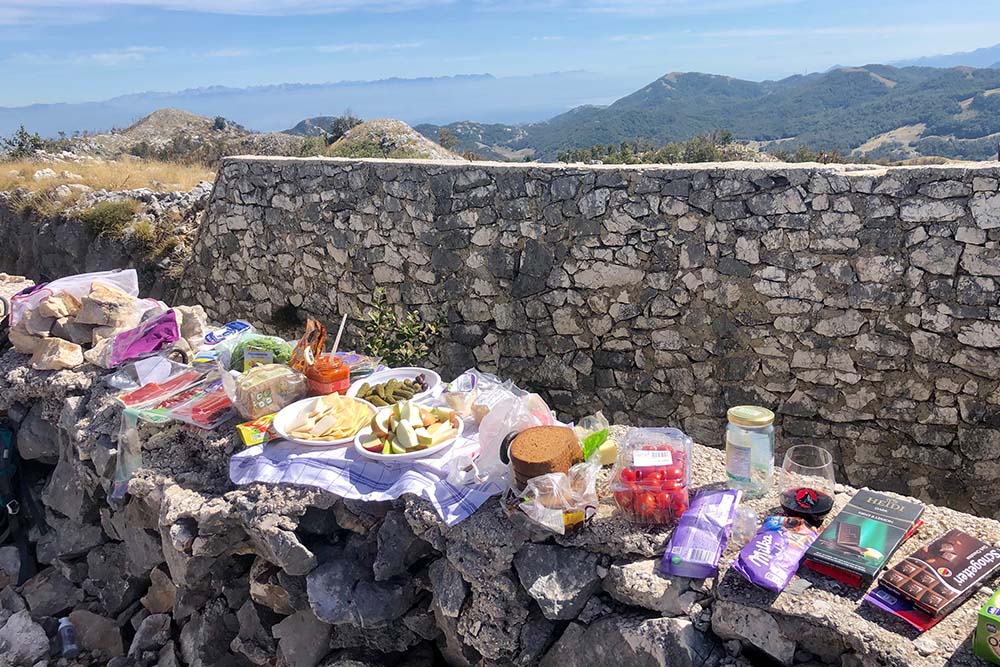 Montenegro’s mountain meals are simple and savory. The food is mostly Slavic with Turkish, Greek and Hungarian touches. From pan-cooked crispy cutlets to tender stews, pork is a staple. The Balkan version of Sunday roast, Ispod Saca, is made from slow-roasted veal, lamb or goat, with potatoes, carrots and paprika.
Montenegro’s mountain meals are simple and savory. The food is mostly Slavic with Turkish, Greek and Hungarian touches. From pan-cooked crispy cutlets to tender stews, pork is a staple. The Balkan version of Sunday roast, Ispod Saca, is made from slow-roasted veal, lamb or goat, with potatoes, carrots and paprika.
Hotel breakfasts feature baked goods, fresh fruit and local meats like air-dried sausages and Njegusi prosciutto. At the bakery, try Burek, a spiral-shaped filo pastry filled with cheese, meat, spinach or potato. Kebabs and Cevapi, minced pork and beef sausages, make good mid-day snacks, served with tomato and cucumber salad.
Coastal flavors are more Italian and Mediterranean. Buzara is a rich stew of shellfish, prawns and shrimp simmered in a wine broth. Black risotto combines cuttlefish ink, white wine, garlic and nutmeg. Your teeth will turn black, but it’s well-worth the gastronomic experience.
No matter the region, hospitality is huge. Guests always get their fill. No meal is complete until the last drop of Rakja, local brandy, is drunk. Niksic beer is especially satisfying after an arduous day of hiking.


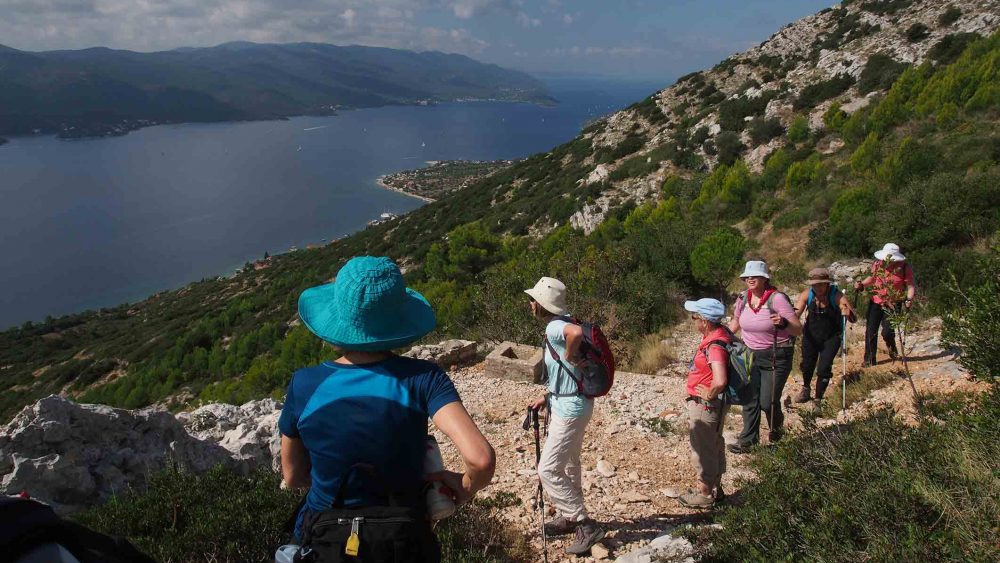
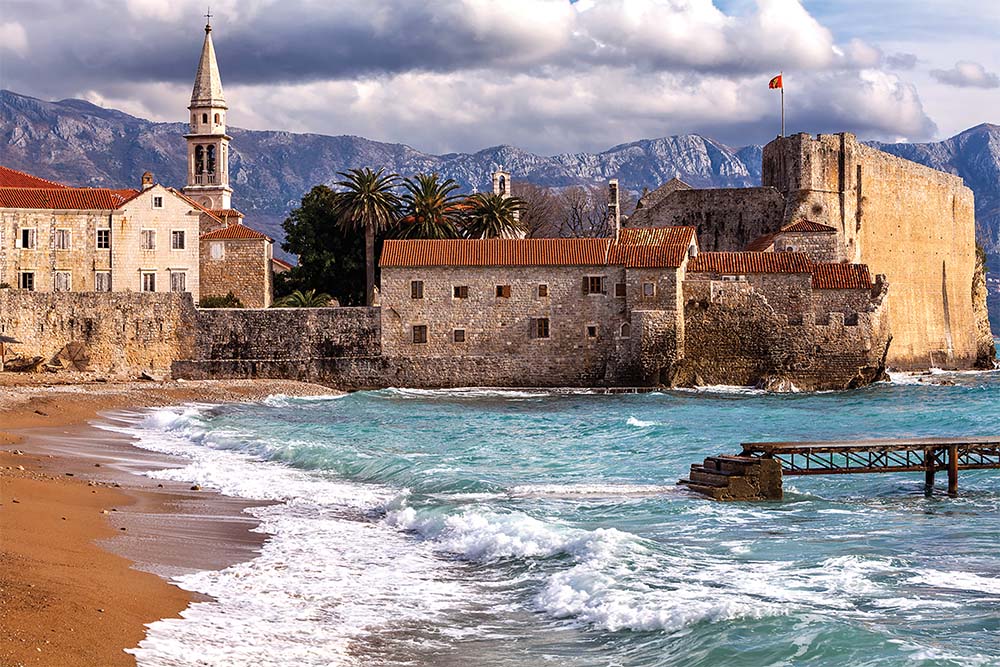







Comments are closed.